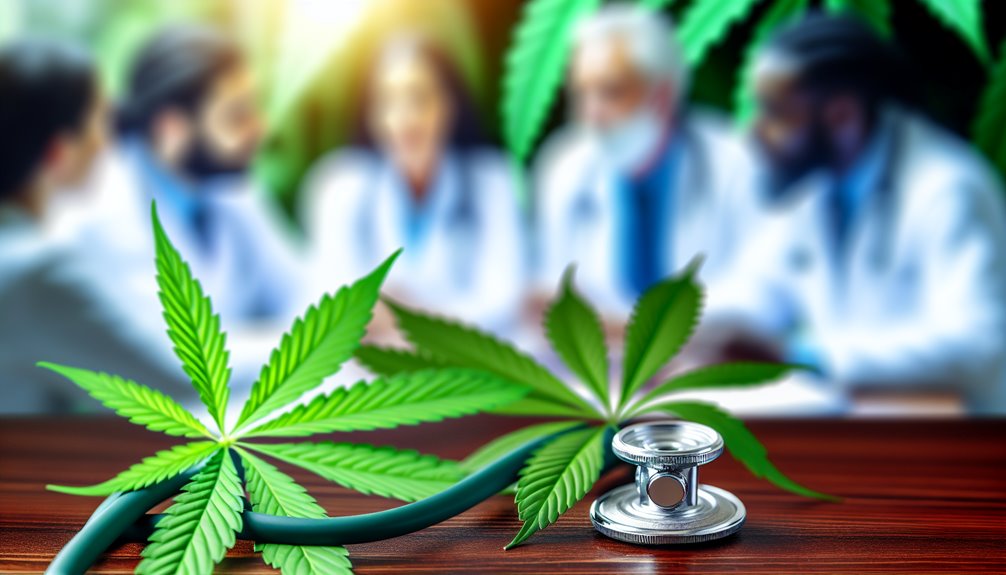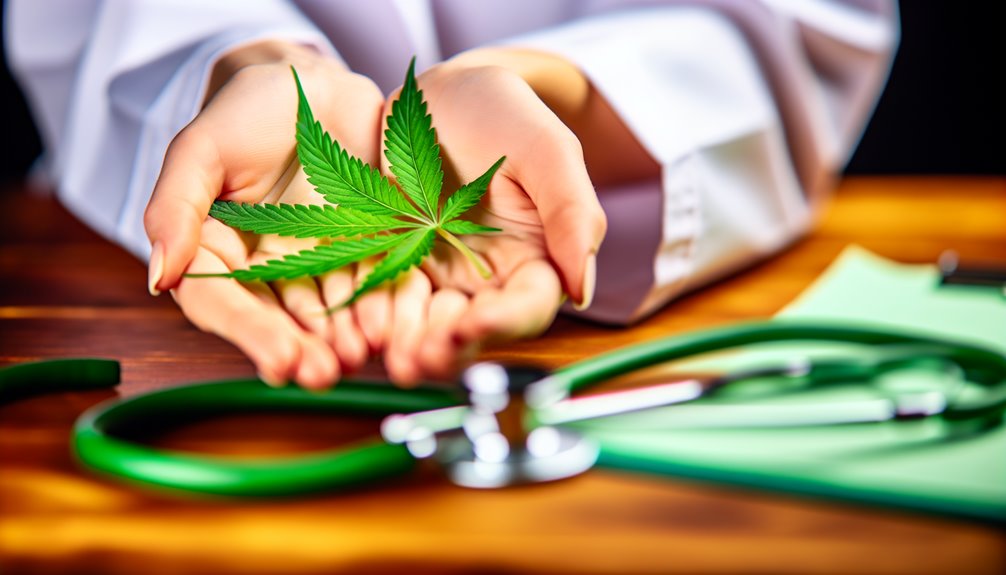Imagine standing in a field of cannabis, your senses inundated with the earthy, pungent aroma of the plant's distinctive foliage. The American Medical Association (AMA) has shed light on this intricate plant, dissecting its complex composition and its therapeutic potential. The balance between benefits, like management of chronic pain, and risks such as mental health concerns, is delicate. With legality varying from state to state, the AMA advocates for physician involvement in patient care. Curious about the evolving landscape of cannabis treatment? Let's dive deeper.
Understanding the Basics of Cannabis and Marijuana

While you may know it as weed, pot, or bud, cannabis refers to the dried parts of the cannabis plant, including its flowers, leaves, stems, and seeds. It's packed with over 100 compounds, with tetrahydrocannabinol (THC) and cannabidiol (CBD) being the most notable. THC is the component that gives you a 'high', while CBD doesn't alter your mind. Understanding cannabis terminology and usage methods is essential. You can smoke it using joints, blunts, or bongs, vape it, or consume it as edibles. Another method is dabbing, which involves inhaling oil concentrates of the plant. Concentrates are potent forms of THC often used in vaping and dabbing. Each method and the frequency of use can impact the effects of cannabis on your body. Additionally, emerging research suggests that cannabinoids may have potential therapeutic applications in treating neurodegenerative diseases and mental health disorders (cannabinoids in treatment).
The Evolving Legal Landscape of Medical Cannabis
As you navigate the complex terrain of medical cannabis, consider the flurry of legislative developments occurring across the United States. State legislation varies widely, from Indiana's move to decriminalize possession and legalize medical usage, to South Carolina's pending Compassionate Care Act. Additionally, Kentucky is pushing for decriminalization and voter legalization of marijuana through the introduction of two significant senate bills. Kentucky's marijuana legislation is a notable development in this ever-changing landscape. These variations create regulatory challenges, from licensing to THC content regulations, each state setting their own standards. Significantly, the Department of Justice's proposed rescheduling of marijuana reflects its growing acceptance as a medical substance. However, this evolving landscape brings public health implications, necessitating further research and stringent surveillance of cannabis cultivation, sales, and use patterns. With this in mind, your role in helping others understand this complicated, evolving legal landscape is more important than ever.
Potential Medical Benefits of Cannabis

In considering the potential medical benefits of cannabis, it's vital to address the four key areas: chronic pain relief, nausea management, multiple sclerosis, and other medical conditions. Cannabis and cannabinoids have been recognized for their efficacy in relieving chronic pain, with a notable reduction in opioid prescriptions. As for nausea and vomiting, especially those induced by chemotherapy, cannabinoid therapy has proven effective. When it comes to multiple sclerosis, short-term use of cannabinoids improves spasticity symptoms. Additionally, cannabis potentially has therapeutic uses in conditions such as epilepsy and may help reduce alcohol consumption. Research is ongoing to determine its full potential. It's vital to understand these benefits in the context of serving patients better.
Risks and Side Effects of Marijuana Usage
It is crucial to balance the potential benefits of cannabis with an understanding of its risks and side effects. Regular marijuana use considerably impacts your cardiovascular health, increasing the risk of heart failure, heart attack, and stroke. Regarding mental health, it can affect memory, learning, and decision-making, leading potentially to anxiety, depression, or even psychosis. Lung damage is another serious concern, with smoking cannabis causing harm to lung tissues and blood vessels. The risk of marijuana addiction escalates with increased THC concentration and frequent usage, particularly among youth. Withdrawal symptoms can include irritability and depression. Despite cannabis regulations, the risks remain real and substantial, requiring careful consideration before use.
The Role of Physicians in Medical Cannabis Treatment

Maneuvering the complex landscape of medical cannabis treatment, you, as a physician, must balance ethical, legal, and clinical responsibilities. Your role is pivotal in patient assessment and education. Ethically, you shouldn't recommend treatments you're uninformed about, including their composition, dose, or side effects. Legally, despite some states allowing medical cannabis, federal law still classifies it as a Schedule 1 drug. Clinically, you're tasked with providing a detailed explanation on the therapeutic use of medical cannabis, alongside its potential risks and benefits. Prioritize a bona fide clinical relationship, with annual reassessments to ascertain if patients still suffer from debilitating conditions. This intricate balance guarantees you navigate the perplexing terrain of medical cannabis treatment proficiently.
AMA's Position on the Use of Cannabis and Marijuana
While the American Medical Association (AMA) stands firmly against the legalization of cannabis for adult use, they've advocated for its decriminalization. In this context, decriminalization policies focus on public health-based strategies over incarceration for personal use possession. Despite reservations, the AMA supports expunging past marijuana convictions where cannabis legalization has occurred. Concurrently, they oppose state-by-state legalization until thorough research validates safety and efficacy. They've backed legislation like the Medical Marijuana and Cannabidiol Research Expansion Act of 2022 to enhance these efforts. Although acknowledging potential health improvements from medical cannabis, they urge caution due to potential adverse events and support legislation protecting physicians recommending cannabis according to state laws.
Future Perspective: Trends and Research in Cannabis Medicine

Diving into the future of cannabis medicine, you'll find research extending beyond well-known cannabinoids like THC and CBD. Scientists are uncovering the therapeutic potential of emerging cannabinoids such as CBG, CBN, and THC-V, paving the way for cannabinoid advancements.
Innovations in cultivation techniques, like Controlled Environment Agriculture and genetic engineering, are ensuring consistent quality while prioritizing sustainability. These advancements are enabling the development of personalized therapies, tailoring treatment plans based on your unique characteristics, including genetics, lifestyle, and health status.
Innovative delivery methods like vaporization and transdermal patches aim to improve bioavailability and patient adherence, while research is focusing on the effectiveness of different strains, dosages, and consumption methods. The future of cannabis medicine is bright, promising more accurate and effective treatments for various conditions.
Conclusion
While the AMA acknowledges the healing prowess of cannabis, they also urge vigilance about its potential pitfalls. You, as a patient, must rely on your doctor's wisdom to navigate this evolving landscape. After all, the grass isn't always greener on the other side. But with careful research and judicious use, this 'green medicine' might just turn out to be a game-changer in healthcare. Stay tuned for the future of cannabis medicine; it promises to be an intriguing journey.
If you're curious to learn more about how cannabis can benefit your health, I warmly invite you to visit Fells Point Cannabis Docs of Maryland or give them a call at (410) 401-4200. Their knowledgeable staff is ready to answer your questions and guide you through the process. Don't hesitate to reach out—discovering the potential of cannabis could be the next step in your healthcare journey!
